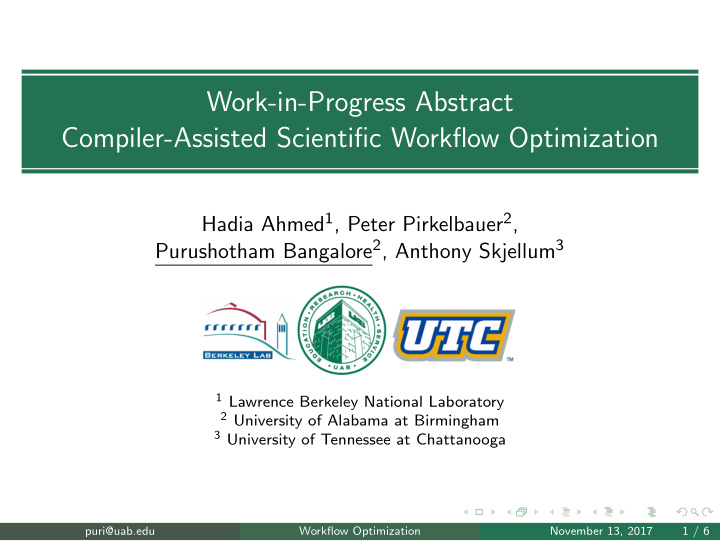



Work-in-Progress Abstract Compiler-Assisted Scientific Workflow Optimization Hadia Ahmed 1 , Peter Pirkelbauer 2 , Purushotham Bangalore 2 , Anthony Skjellum 3 1 Lawrence Berkeley National Laboratory 2 University of Alabama at Birmingham 3 University of Tennessee at Chattanooga puri@uab.edu Workflow Optimization November 13, 2017 1 / 6
Introduction Exascale Systems Data analytics will face tremendous challenges on Exascale systems Many compute nodes communicate with analytics nodes Simulations produce vast amount of data In-situ (in-transit) analytics necessary to deal with limited bandwidth Simulation / analytics code need to be re-organized puri@uab.edu Workflow Optimization November 13, 2017 2 / 6
Idea Describe Re-organization Users specify re-organization with an annotation language Tool generates optimized version Move code from analytics node to simulation (or vice versa) Describe reductions . . . puri@uab.edu Workflow Optimization November 13, 2017 3 / 6
Approach Compiler-based Use ROSE to read, analyze, and re-organize source files puri@uab.edu Workflow Optimization November 13, 2017 4 / 6
Early Results Restructure Bonds-CSym On a single system, we achieved speedups between 4% and 12%. Restructured Bonds-CSym in a 1:1 configuration Re-organized code Eliminates storage to file system Eliminates data container conversion Enables further compile-time optimizations Bonds-CSym is quadratic, smaller input sizes exhibit larger speedups Reduced need for network communication puri@uab.edu Workflow Optimization November 13, 2017 5 / 6
Thank you contact: Peter Pirkelbauer (UAB) e-mail: pirkelbauer@uab.edu puri@uab.edu Workflow Optimization November 13, 2017 6 / 6
Recommend
More recommend